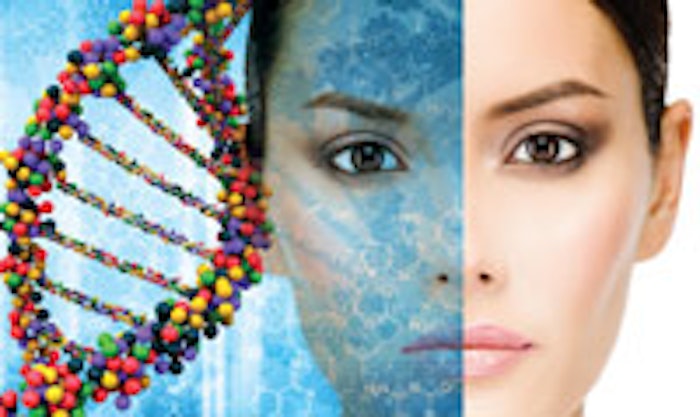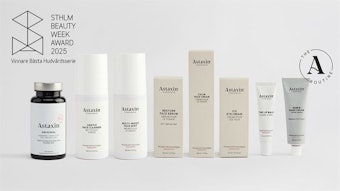
Editor’s note: As always, Skin Inc. magazine recommends that skin care professionals obtain the proper training before offering any new treatments in their skin care facilities.
Author’s note: Studies indicate that a daily dose of 50,000 IU provides safe protection against sun exposure and skin cancer, though it should be noted that excess doses of vitamin A can result in negative side effects, including hair loss, dry skin, nausea and liver damage, and pregnant women should not exceed more than 10,000 IU daily without a doctor’s supervision. Recommend that clients consult with their physicians before starting any supplement program.
Since Albert Kligman, MD, PhD, the late renowned dermatologist, patented the retinoic acid drug tretinoin in 1973, vitamin A is still recognized as the single most proven go-to ingredient for improving everything from acne, wrinkles and collagen synthesis to hyperpigmentation. Even today, following the advent of peptides, peels and stem cells, vitamin A and its retinoid-derivative family continue to reign as the unequivocal gold standard of skin care, particularly in treating photodamage. This tried-and-true ingredient continues to evolve with new applications and outcomes coming to light, helping it continue its reign as one of the most potent ingredients in the skin care professional’s arsenal.
How retinoids work
Years after Kligman started testing retinoic acid on acne patients in the 1960s, he began to notice patients were also exhibiting fewer wrinkles and a smoother skin tone. Additional research revealed that, by binding to specific receptors in the skin, retinoids encourage cell turnover on the top layers, producing a more even skin tone, while thickening the lower dermal layers, which has a smoothing effect on wrinkles.
Retinoids’ core competency—the organization, division and differentiation of skin cells—is at the very heart of addressing so many skin conditions, from acne and signs of aging to psoriasis. Indeed, many physiological responses of the skin, such as dermal aging, immune defense and wound-healing, are affected by vitamin A and its retinoids. This potent, water-soluble antioxidant not only encourages proper cell desquamation, but also helps maintain the skin’s structure by inhibiting the DNA damage that breaks down collagen.
In the correct molecular size, retinoids can penetrate the lower layers of skin where collagen and elastin are produced, DNA repair functions occur and the cell cycle is regulated. Once a topical retinoid is applied, enzymes convert the retinoid into retinoic acid, which binds to the DNA via receptors and activates the skin’s genes to promote healthier cell growth.
The retinoid range
Retinoids range from natural to synthetic, and pharmaceutical to nonpharmaceutical derivatives. This article will focus on the three basic nonprescription retinoid derivatives: retinyl palmitate, retinol and retinaldehyde.
Think of retinoids existing on a continuum with the lipid-based retinyl palmitate on the far left side of the spectrum, and representing the most stable and least irritating—but also the least potent—version. This derivative must undergo the most number of steps to convert to retinoic acid, the bioavailable form used by the body. It must first convert to retinol and then to retinaldehyde before converting to retinoic acid. On the other end of the continuum, pharmaceutical retinoic acid is far less stable and potentially irritating, but also highly effective at treating acne and signs of aging.
Although many mass-marketed products feature retinyl palmitate, most anti-aging cosmeceuticals feature either retinalydehyde, which exists one step away from retinoic acid, or retinol, which sits between retinyl palmitate and retinaldehyde on the retinoid continuum. Both offer a readily available, nonprescription source of topical vitamin A that’s easily converted into retinoic acid.
A randomized double-blind controlled study, published last year in the Journal of Drugs in Dermatology, found little difference in efficacy between a 1.1% retinol-based gradual-release cream and a prescription tretinoin (retinoic acid) 0.025% cream in women with mild to moderate photodamage. Following a three-month treatment, both test products significantly improved photodamage, including fine and coarse wrinkles around the eye, skin firmness, tone and texture, pigmentation and general photodamage. The subjects reported more than 93% overall satisfaction with both products at the eighth and 12th weeks.1
Retinaldehyde presents another viable option for acne and anti-aging formulations. A 2010 study published in the Aesthetic Surgery Journal concluded that, according to the current data, cosmeceuticals containing retinaldehyde had been shown in large randomized controlled trials to have the most beneficial affect on aging skin among the retinoid-based cosmeceuticals.2 In addition, in a large international study published in the Journal of Cosmetic Dermatology in 2011, researchers found that a combination of retinaldehyde and hyaluronic acid applied over three months showed significant improvement to photoaging, with more than a 30% improvement to elasticity and hyperpigmentation.3
For acne-sufferers, retinaldehyde may be a prime choice among retinoids for its less irritating profile and compatibility with other potentially irritating acne treatments, including alpha hydroxy acids (AHAs) and benzoyl peroxide. A 2007 Dermatology study showed favorable outcomes with a topical 0.1% retinaldehyde combined with 6% glycolic acid in treating acne.4, Another study published in Dermatology demonstrated that retinaldehyde at an 0.05% level may also offer some antimicrobial activity against Propionibacterium acnes bacteria.5
Improving outcomes
Although retinoids offer many benefits to the skin, they often come at a price. The more potent forms are unstable and light-sensitive, creating formulation issues in the wrong hands. Many clients also find retinoids—particularly retinoic acid—irritate their skin with daily use. An Italian study published last year in the Journal of Dermatological Treatment noted that irritation was the most frequent side effect of topical retinoids, occurring in 85% of nonprescription retinoid users and up to 95% in patients treated with tretinoin. As a result, 15% of the patients terminate their tretinoin treatment for this reason.6 In that study, the researchers found that short contact therapy with a 0.05% tretinoin cream applied once daily for 30 minutes during an average 12-week period demonstrated significant clinical improvement in acne treatment with very good tolerability and, as a result, improved compliance.
To overcome irritation and stability issues, retinol chemists have also used specialized delivery forms that encapsulate active retinol in a polymer system to slowly “feed” the skin a more stable, bioactive form with minimal irritation. Chemists formulating with retinol must take special care to process the batch in a special controlled environment, with yellow lights and nitrogen gas-blanketing to reduce oxidation.
New research is revealing fresh insights regarding different combinations of ingredients. For instance, a soy-based active complex known as Allosteris from Barnet Products Corporation, makes the perfect partner with retinol by increasing its efficiency at a lower usage percentage, thus decreasing the potential for irritation. Whereas a formulation without Allosteris may need a 0.5% or higher level of retinol, formulators can use a 0.03% retinol to 0.5% Allosteris combination and achieve comparable results. Allosteris improves the skin’s reception to signaling molecules, such as retinol and peptides, allowing these molecules to enhance or inhibit a protein or enzyme. On its own in a 1% concentration, in vivo results showed Allosteris increased hydration, decreased wrinkles, improved clarity and firmness, and reduced flakiness in the skin.
Combining retinoids with UV filters may also help mitigate irritation. A Brazilian study published in the International Journal of Pharmaceutics in 2007 found evidence suggesting that photostable UV filters—in this case, octyl methoxycinnamate, benzophenone-3 and octocrylene—might help reduce skin irritation associated with a combination of vitamins A, C and E. They also concluded that the photostable UV filters combination yielded the highest recovery of vitamin A compared to a photo-unstable formula.7
Also, dermal needling has become a popular treatment in recent years. Using approximately 200–250 fine surgical steel needles, a roller mechanism is applied directly to the skin in a repetitive crisscross motion. It creates microchannels in the skin that encourage up to 80% product absorption. It also induces a controlled wound that triggers a slow wound-healing response in the skin and promotes desired scarless collagen to replace damaged collagen. Dermal needling yields complete preservation of the melanocyte cell and helps to regulate the melanogenesis promoting an even skin tone. It also triggers growth factors within the client’s kertinocytes, which encourages healthy cell-to-cell communication. (Editor’s note: Dermal needling may not be within your scope of practice. Contact your state board and obtain the necessary training before adding this treatment to your menu. Log on to www.SkinInc.com/education/statelicensing for complete contact information for your state’s board.)
Coupling a dermal needling procedure and vitamin A (retinol 4%) serves as an impressive anti-aging treatment. Retinol encourages epidermal thickness and inhibits metalloproteinase (MMP), which is an enzyme that degrades collagen. Pairing the two refines skin texture and tone, reduces fine lines and increases cellular turnover. (See Treatment How-to: Retinol Facial with Dermal Needling
Beyond acne and aging
Although retinoids have been used traditionally to treat acne and aging, researchers are now finding new applications for vitamin A derivatives. A 2006 study published in the Journal of Cosmetic Dermatology found that a retinol-based cream coupled with intense pulsed light may help improve cellulite by enhancing collagen and improving smoothness in the affected areas with minimal side effects.8
Retinoids may also help treat skin cancer. A recent study in the Journal of Investigative Dermatology that analyzed melanoma risk among nearly 70,000 people found that vitamin A supplement-users were approximately 40% less likely to develop melanoma than the nonsupplement users.9 The news is particularly encouraging for those at high risk for melanoma, such as fair-skinned individuals with a history of sunburn and numerous moles.
Although researchers continue to search for the next best ingredient to fight acne and aging, it’s likely that retinoids will remain trusted, proven ingredients in the skin chemist’s formulary for acne and anti-aging, as well as additional applications in the future.
REFERENCES
1. ET Ho, NS Trookman, et al, A randomized, double-blind, controlled comparative trial of the anti-aging properties of non-prescription tri-retinol 1.1% vs. prescription tretinoin 0.025%, J Drugs Dermatol 11 1 64–69 (Jan 2012)
2. K Babamiri and R Nassab, Cosmeceuticals: the evidence behind the retinoids, Aesthet Surg J 30 1 74–77 (Jan 2010)
3. A Corderom, G Leon-Dorantes, et al, Retinaldehyde/hyaluronic acid fragments: a synergistic association for the management of skin aging, J Cosmet Dermatol 10 2 110–117 ( Jun 2011)
4. B Dreno, A Katsambas, et al, Combined 0.1% retinaldehyde/6% glycolic acid cream in prophylaxis and treatment of acne scarring, Dermatology 214 3 260–267 (2007)
5. M Pechère, JC Pechère, et al, Antibacterial activity of retinaldehyde against Propionibacterium acnes, Dermatology 1 29–31 (1999; 199 Suppl)
6. S Veraldi, M Barbareschi, et al, Short contact therapy of acne with tretinoin, J Dermatolog Treat (Jan 20, 2013) (E-pub ahead of print)
7. LR Gaspar and PM Campos, Photostability and efficacy studies of topical formulations containing UV-filters combination and vitamins A, C and E, Int J Pharm 343 1–2 181–189 (Oct 1, 2007)
8. JS Fink, H Mermelstein, et al, Use of intense pulsed light and a retinyl-based cream as a potential treatment for cellulite: a pilot study, J Cosmet Dermatol 5 3 254–262 (Sep 2006)
9. MM Asgari, TM Brasky, E White, Association of vitamin A and carotenoid intake with melanoma risk in a large prospective cohort, J Invest Dermatol 132 6 1573–1582 (Jun 2012)











